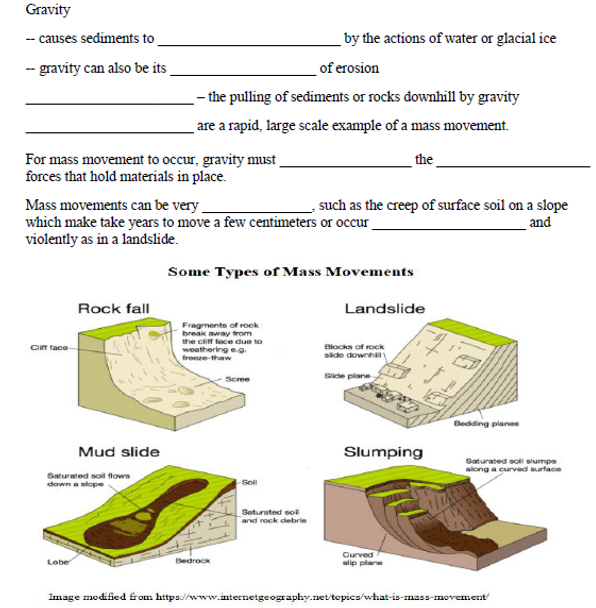Description
This zip file contains many different activities (80 pages of student handouts and a 2 PowerPoints with a total of 156 slides) which can be used to compose a unit involving Weathering and Erosion. Concepts that are addressed include but not limited to include; mechanical weathering, chemical weathering, stream erosion, stages in stream evolution, glacial erosion and deposition, sand erosion and deposition, wave erosion and deposition and some human impacts on erosion. The learning objectives and specific contents of this set of materials is listed below. This set of activities is suited for many earth science, environmental science or physical science classes. With teacher guidance, many components in these materials are adaptable to an enriched middle level science curriculum.
All documents are in PowerPoint, word or pdf format to allow you to edit the documents to meet your needs. Many of the activities in this package of activities are well suited and easily modified for use in distance learning environments. Answer keys for all student activities are provided.
The specific contents of materials in the package are as follows:
- Learning Goals and Objectives (Including NGSS, Common Core and NY State Earth Science Core Curriculum) (2 pp.)
- Weathering and Erosion Completion Notes (23 pp.)
- PowerPoint to support the Completion Notes (includes 5 closure ticket out activities) (82 slides)
- Weathering and Erosion Worksheet 1 (Weathering) (34 questions) (9 pp.)
- Weathering and Erosion Worksheet 2 (Erosion I) (47 questions) (11 pp.)
- Weathering and Erosion Worksheet 3 (Erosion II) (47 questions) (14 pp.)
- Weathering and Erosion Exam (40 questions) (9 pp.)
- Reaction Rates Lab using Alka-Seltzer (2 pp.)
- Mechanical Weathering and Abrasion Lab (10 pp.)
- Weathering and Erosion Jeopardy PowerPoint (31 questions) (74 slides)
Weathering and Erosion Learning Standards and Objectives
NGSS Standards: HS-ESS2-1, HS-ESS-2-5
Common Core State Connections:
ELA/Literacy: RST 11-12.1, RST 11-12.2, WHST 9-12.1
Mathematics: MP.2
New York State Physical Setting/Earth Science Core Curriculum
Standard 1: Mathematical Analysis: Key Idea 2
Standard 1: Scientific Inquiry: Key Idea 2
Standard 4: Performance Indicator 2.1: Major Understandings 2.1 s, 2.1 t, 2.1 u, 2.1 v
Learning Objectives
Upon the completion of this unit the student will be able to:
1. define the terms weathering and erosion.
2. list several examples of chemical weathering.
3. explain why carbonate rocks such as limestone and marble are more easily chemically weathered.
4. list and explain several mechanisms of chemical weathering.
5. explain how physical and chemical weathering differ.
6. list several factors that influence the rate of weathering.
7. recognize chemical weathering occurs more rapidly in warm and wet climates.
8. briefly describe how soil is formed.
9. list the basic components of erosional transport systems.
10. recognize that water is the dominant agent of erosion on the earth.
11. recognize that gravity is the most frequent driving force for erosion.
12. explain what is meant by mass movement and list several examples of this.
13. define the terms stream, tributary and watershed.
14. list several ways streams carry sediments.
15. explain how abrasion produces rounded particles in a stream.
16. relate stream velocity to the size of the particles it can carry.
17. recognize that it takes longer to weather harder rock materials.
18. identify U-shaped valleys as being associated with most stream erosion.
19. list several characteristics of young, mature and old streams.
20. explain how meanders, oxbow lakes and deltas are formed.
21. explain why erosion tends to occur on the outside of a meander, while deposition occurs on the inside of the meander.
22. recognize the sediments deposited by a stream are sorted.
23. identify some major locations subject to wind erosion.
24. discuss some ways wind weathering and erosion occur.
25. identify the predominant wind direction in a region based upon the appearance of its sand dunes.
26. list the conditions required for glacier formation.
27. distinguish between alpine and continental glaciers.
28. recognize continental glaciers are associated with the ice ages.
29. describe how glaciers move and how this results in their erosion of land.
30. recognize that glaciers tend to form U-shaped valleys.
31. identify the following features related to glacial erosion; striations, hanging valleys, kettles, erratics, cirques, aretes, horns, eskers, kames, drumlins, moraines and outwash plains.
32. recognize that glacial erosion with the exception of outwash plains tends to produce unsorted deposits.
33. explain how Long Island geology has been modified by glaciation.
34. recognize the role of wind energy in the formation of waves.
35. explain how longshore currents are formed and determine the direction of their flow.
36. explain how breakers are formed.
37. identify several geological features produced by wave erosion.
38. list some human activities that make the land more vulnerable to erosion.
39. list several practices that can reduce excess land erosion.
Terms of Use
Purchase of the product is for classroom use by the purchaser only. It is a violation for individuals, schools, and districts to redistribute or sell this item on the Internet or to other individuals. I do encourage you to use and edit these documents to suit your needs with your own students in distance learning environments.
This work is licensed under a Creative Commons Attribution-NonCommercial-ShareAlike 4.0 International License.


















